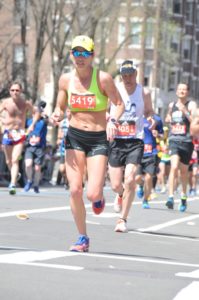
Running out of one of the tunnels, Saints and Sinners Half Marathon 2018.
Runners are often caught up in numbers. We measure our runs by distance or time, and often chalk the success of a run or determine our fitness by our paces. While numbers should certainly play a motivating and informative role for many runners, it’s important to listen to our bodies. After all, a 10:00 minute mile may be a sprint for one runner, a tempo pace for another, and a recovery pace for a third. While 10:00 minute miles will always equal 6 miles per hour, what that pace feels like will vary per person. And that’s incredibly important – especially for newbies or runners coming back from a hiatus or injury.
Despite all the cool techie gadgets, our bodies simply understand exertion or effort. It’s important for us to be able to honestly feel our efforts and listen to our bodies. Most weekly runs, regardless of talent or speed, should be done at an easy/moderate effort. Most miles should feel low stress. That effort will give us all different numbers. That number may also greatly swing one way or another based on weather, altitude, sleep, nutrition, and so on. Perhaps one of the greatest mistakes most runners make is running too much at an effort greater than prescribed. I’d be the first to admit that for years I’d run my recovery runs too fast, and then I’d be wiped out and cooked before I’d even start a speed workout.
Learning to listen to our bodies and understand our efforts takes consistency, time, practice, and self awareness. I recommend runners ditch the music whenever possible, so that they can tune into their body, form, breath rhythm and run without distractions.
It’s also important to remember that our devices can crap out. While GPS watches and apps. can give us useful data; buildings, mountains, tunnels, and simply bad weather can mess with our device. If you are 100% relying on that device, your workout or race could greatly suffer. It sucks when technology fails us, but there should be a calm confidence in knowing your body as a runner.
For my new runners, I try to stress the importance of exertion. For one thing, we are completely shooting in the dark if I tell a new runner to run 10:00 minute miles for their first run. That number could be way off base and inappropriate for them. Instead, go for a run and keep the exertion to comfortable/conversational, or a 4-6 out of 10 exertion and no harder. That device can then later give clues as to the current fitness based on the number on the watch, assuming the exertion was honest, and how to gently progress their training.
To drive this concept home, I’ve known a few coaches in my day who don’t want their athletes looking at their watches during track workouts. Even with a very specific time goal, working incredibly hard, some coaches want their athletes to lock that rhythm and effort into their body. To be huffing and puffing and thinking “yep, this feels like a 10:00 minute mile,” without the watch can almost feel like running blind. While I used to constantly look at my watch, I’ve slowly tried to learn to rely on myself more and my watch less. I still glance at my watch during my track workouts, but now only halfway through that repeat or interval.
When a watch malfunctions on a training run it can be frustrating. When it happens on a race course, it can be the thing that truly throws a runner off their game. If that happens, relax and focus on your exertion. Use mile markers, and try to do the math in your head. If you know the course elevation, you’ll know where you can potentially cruise and where you’ll need to really dig deep.
Just the other weekend at Saints and Sinner’s Half Marathon, my watch went crazy during the second half. The first half of the course is essentially in the desert. No big trees, mountains or buildings, it’s simply open. The first half is also incredibly fast, and so it was a strategy to go out and use the downhills to bank some time for the gravel portion. The second half includes about a dozen tunnels, and you hug part of a mountain. I expected my GPS to get a bit off (the race website gives a head’s up to expect this), but it also happened at the place in the course where you are on gravel, and have a little uphill. Suffice to say, not the easiest place physically or mentally to have focus unravel. Despite the slowing time on my watch, I told myself to keep my head up and keep grinding. I knew the final 2.5 miles would be fast, and I just had to hang tight.
Here’s my splits according to my Garmin:
5:42, 5:52, 5:49, 6:17, 6:02, 6:07, 6:29, 6:39, 6:42, 6:33, 6:22, 6:05, 5:27 (for .92 miles). GPS finish had 12.92 miles, so it was off by almost a quarter mile.
Now, I could have totally lost my head out there during miles 7-10. In fact, a few years ago I probably would have shut down. But being able to focus on my form and exertion, while reminding myself that a PR was going to demand a whole lot of discomfort – I was able to focus on the mile markers and do the math in my head. Knowing my goal was just slightly out of reach was enough for my to keep fighting.
Last year at Boston Marathon, my exertion and watch weren’t matching up. Between the warm weather and being on antibiotics for bronchitis, I stubbornly went out at my goal pace. By mile 14, I knew my exertion was way too high to sustain for the remaining 12 miles. I could feel myself quickly dehydrating, and the effort and pace wasn’t sustainable. On that day I decided to pull back on the pace and not fight myself. If I had married myself to the watch and the plan, the odds are good things would have gotten incredibly ugly out there.
My hope is that whether a newbie or an experienced running veteran, you embrace the concept of exertion. The better you know your body, the wiser an athlete you can be.
 This past weekend I stepped up to the starting line of my first of two big goals for 2018. After an amazing experience at
This past weekend I stepped up to the starting line of my first of two big goals for 2018. After an amazing experience at  The new year is on the horizon, and you have decided you are going to take up running! Great! Here are some tips to help you ease into a new sport carefully, so that you reduce injury risk, build as a runner, and have fun. Be patient and remember to accept that you can’t be an expert in anything overnight. Enjoy the journey and learn from your experience.
The new year is on the horizon, and you have decided you are going to take up running! Great! Here are some tips to help you ease into a new sport carefully, so that you reduce injury risk, build as a runner, and have fun. Be patient and remember to accept that you can’t be an expert in anything overnight. Enjoy the journey and learn from your experience. Races that go well and exceed every expectation make running feel so incredibly liberating. They are satisfying, empowering and simply fun. It’s these races that usually motivate us to keep signing up and racing.
Races that go well and exceed every expectation make running feel so incredibly liberating. They are satisfying, empowering and simply fun. It’s these races that usually motivate us to keep signing up and racing. Last week I posted about the importance of the off season. Today I want to personally share how I handled my off season, and what lessons I learned about myself as an athlete in my latest marathon cycle, and how I’ll plan to make changes in the future. It’s important to understand that our bodies will adapt and change to anything we toss at it – with time, consistency, and a solid combination of work and recovery. It’s always easier to be the coach than the athlete, and I’ve worn both hats for myself for the last few years. While I know my body and my strengths and weaknesses, it’s not without its challenges.
Last week I posted about the importance of the off season. Today I want to personally share how I handled my off season, and what lessons I learned about myself as an athlete in my latest marathon cycle, and how I’ll plan to make changes in the future. It’s important to understand that our bodies will adapt and change to anything we toss at it – with time, consistency, and a solid combination of work and recovery. It’s always easier to be the coach than the athlete, and I’ve worn both hats for myself for the last few years. While I know my body and my strengths and weaknesses, it’s not without its challenges.


